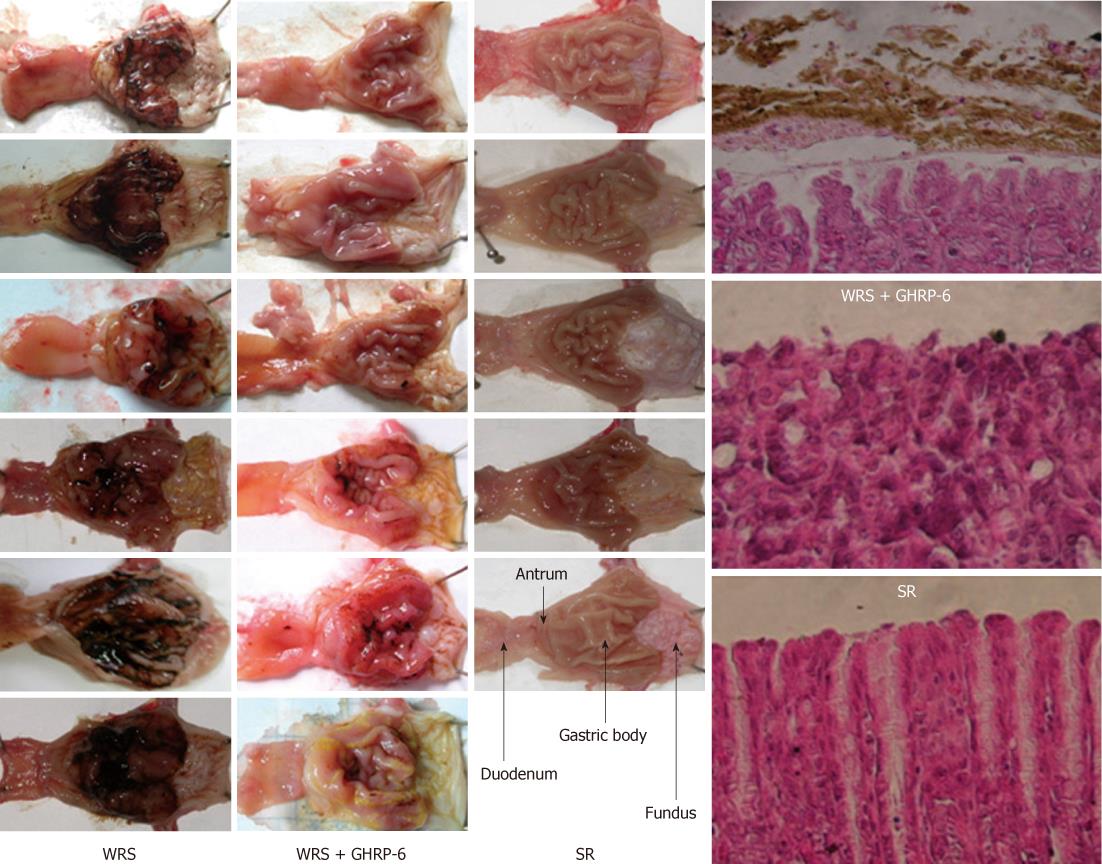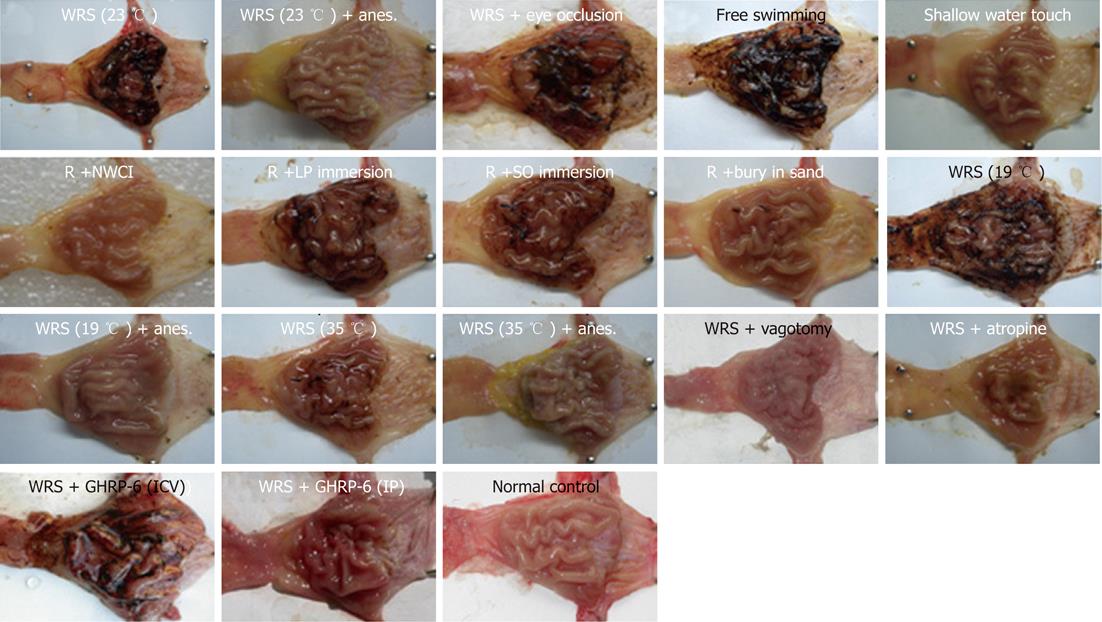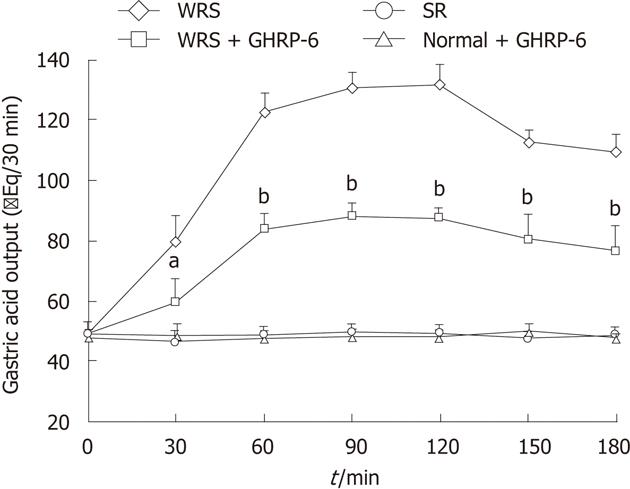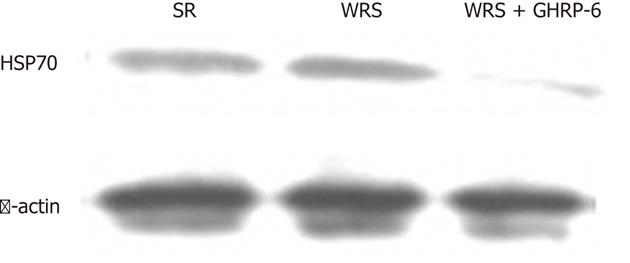Copyright
©2012 Baishideng Publishing Group Co.
World J Gastroenterol. Jun 28, 2012; 18(24): 3145-3155
Published online Jun 28, 2012. doi: 10.3748/wjg.v18.i24.3145
Published online Jun 28, 2012. doi: 10.3748/wjg.v18.i24.3145
Figure 1 Gross anatomy of rat gastric mucosa in different groups.
Left three columns: The gross inspections of the gastric mucosa in water immersion restraint stress (WRS), WRS + growth hormone releasing peptide-6 (GHRP-6) and simple restraint (SR) groups, respectively. Note that there were serious mucosal hemorrhages (black color) in the WRS group, while the hemorrhage was minimal in the WRS + GHRP-6 group. No mucosal hemorrhage was observed in the SR group; the forth column: Hematoxylin-eosin staining of the mucosa, mucosal structure disruption and hemorrhage (brown color) were observed in the WRS group, but not in the WRS + GHRP-6 and SR groups.
Figure 2 Representative pictures of the gastric mucosa in different groups.
WRS: Water immersion restraint stress; R: Restraint; NWCI: Immersion without water contact; LP: Liquid paraffin; SO: Salad oil; Anes.: Anesthesia; ICV: Intracerebroventricular injection; IP: Intraperitoneal injection.
Figure 3 Heart rate variability analyses showing the differences in mean R-R intervals, standard deviation of the normal-to-normal R-R intervals and root mean square of successive difference of R-R intervals in different groups.
Note that the mean R-R intervals gradually prolonged along with the progress of water immersion restraint stress (WRS), whereas this prolongation was much less in the WRS + growth hormone releasing peptide-6 (GHRP-6) group. The mean R-R intervals were shortened in the simple restraint (SR) group. The changes in standard deviation of the normal-to-normal (SDNN) and root mean square of successive difference (RMSSD) was more significant in WRS group than the other two groups. aP < 0.05, bP < 0.01 vs WRS+GHRP-6 group.
Figure 4 Pointcaré plots of the R-R intervals in different groups.
A: The plots indicate that heart rate decreased gradually with time, and heart rate variability (HRV) was increased as shown by the scattered pattern of the plots in the water immersion restraint stress (WRS) group, suggesting vagal overactivity in this group; B: Changes of the heart rate and HRV in the WRS + growth hormone releasing peptide-6 (GHRP-6) group were much less than the WRS group; C: In the simple restraint (SR) group, the heart rate increased and the HRV was decreased as shown by the condensed geometry of the plots, suggesting increased sympathetic activity in this group.
Figure 5 Gastric acid output in different groups.
Note that water immersion restraint stress (WRS) induced significant increase in gastric acid output and growth hormone releasing peptide-6 (GHRP-6) (intraperitoneal) significantly suppressed this increase. Simple restraint (SR) and GHRP-6 alone did not change the gastric acid output. aP < 0.05, bP < 0.01 vs WRS group.
Figure 6 Western blotting showing gastric mucosal protein levels of heat shock proteins 70 in different groups.
Note that there was substantial expression in the water immersion restraint stress (WRS) and simple restraint (SR) groups, whereas the expression was minimal in the WRS + growth hormone releasing peptide-6 (GHRP-6) group. HSP70: Heat shock proteins 70.
- Citation: Guo S, Gao Q, Jiao Q, Hao W, Gao X, Cao JM. Gastric mucosal damage in water immersion stress: Mechanism and prevention with GHRP-6. World J Gastroenterol 2012; 18(24): 3145-3155
- URL: https://www.wjgnet.com/1007-9327/full/v18/i24/3145.htm
- DOI: https://dx.doi.org/10.3748/wjg.v18.i24.3145














